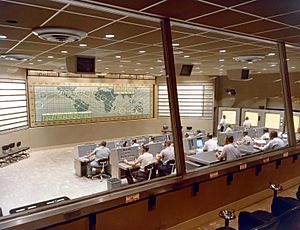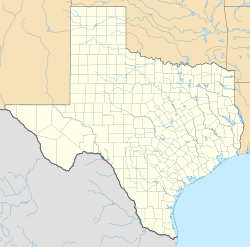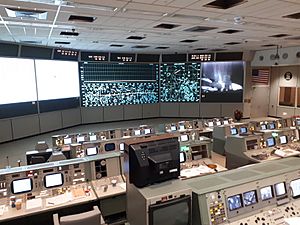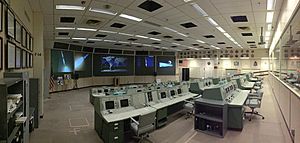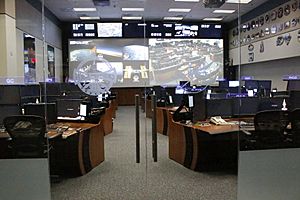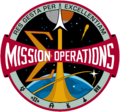Christopher C. Kraft Jr. Mission Control Center facts for kids
The Christopher C. Kraft Jr. Mission Control Center (MCC-H), often called Houston, is a very important place for America's human space program. It's located at the Johnson Space Center in Houston, Texas. This center is where flight controllers manage and guide astronauts in space, especially those aboard the International Space Station (ISS) today.
The center is in Building 30 and is named after Christopher C. Kraft Jr.. He was a NASA engineer and manager who helped create the Mission Control operation. He was also the very first Flight Director.
Today, the MCC has one main control room in Building 30. From here, flight controllers command, watch, and plan everything for the ISS. This room has many computers and tools to keep an eye on the station, send commands, and talk with the astronauts. The ISS control room works all the time, 24/7. There's also a second control room in the same building. It used to be for Space Shuttle flights. Now, it can be used for ISS operations if the main room needs repairs or upgrades. It's also used for training future flight controllers.
Contents
The first American human space missions, like Mercury–Redstone, Mercury-Atlas, and early Gemini flights, were controlled from the Mission Control Center at Cape Canaveral Air Force Station, Florida. This center was known as the Mercury Control Center until 1963.
The building where this control center was located was later taken down in 2010. This was because of concerns about old materials and the high cost of repairs. However, the original control room consoles were saved. They were cleaned up and moved to a special display at the Kennedy Space Center Visitor Complex. Here, visitors can see a re-creation of the historic room.
Houston Takes Over (1965–Present)
Gemini and Apollo Missions (1965-1975)
|
Apollo Mission Control Center
|
|
| Location | Houston, Texas |
|---|---|
| Built | 1965 |
| Architect | Charles Luckman |
| Architectural style | International |
| NRHP reference No. | 85002815 |
Quick facts for kids Significant dates |
|
| Added to NRHP | October 3, 1985 |
| Designated NHL | October 3, 1985 |
The Houston Mission Control Center, located in Building 30 at the Johnson Space Center, began operations in June 1965. Its first mission was Gemini 4. This center had two main rooms called Mission Operation Control Rooms (MOCR).
These two rooms were used to control all Gemini, Apollo, Skylab, and Space Shuttle flights until 1998. Each room had a large, tiered seating area. A big map screen showed the Earth, tracking stations, and the spacecraft's path. Each level of the MOCR had different controllers. Each controller was in charge of a specific part of the spacecraft's systems.
MOCR 1, on the second floor, was used for missions like Apollo 5, Apollo 7, Skylab, and the Apollo-Soyuz Test Project.
Mission Operations Control Room 2

MOCR 2 was on the third floor. It was used for most other Gemini and Apollo flights, including the famous Apollo 11 mission, which was the first Moon landing. Because of its importance, MOCR 2 was named a National Historic Landmark in 1985.
It was last used for a Space Shuttle flight in 1992. After that, it was carefully restored to look almost exactly as it did during the Apollo era. This was done to preserve it for history. Today, it's part of the "Apollo Mission Control Center" on the National Register of Historic Places.
In 2019, after two years of hard work, the restored Apollo-era Mission Control was opened to the public. They even found old items like cigarette packs and ashtrays to make it look just right! Visitors can see the room from a special viewing area at the nearby Space Center Houston visitors' center.
In 2010, voice recordings and film from Apollo 11's landing were put together. This audio was later used for the 2019 restoration of Mission Control.
Space Shuttle Era (1981–2011)
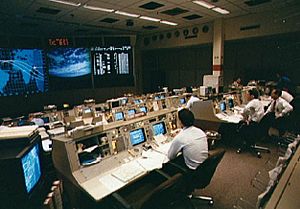
When the Space Shuttle program began, the MOCRs were renamed Flight Control Rooms (FCRs). FCR 1 (formerly MOCR 1) became the first Shuttle control room. FCR 2 was mainly used for secret United States Department of Defense Shuttle flights. Later, it was remodeled back to its Apollo look.
From the moment a space shuttle launched from Florida until it landed, Mission Control was in charge. During a Shuttle mission, the control room was staffed 24 hours a day, usually by three different teams working shifts.
In 1992, a new part was added to Building 30. This new section, called 30 South, opened in 1998. It has two new flight control rooms, named White and Blue. The White FCR was used for all Space Shuttle flights after STS-76. When it wasn't busy with Shuttle missions, the White FCR sometimes served as a backup for the ISS control room.
International Space Station (1998–Present)
The newer part of Building 30 also holds the International Space Station Flight Control Room. The first ISS control room, initially called the Blue FCR, operated non-stop to support the ISS until 2006.
FCR 1, the old MOCR 1, was completely updated in 2006. It got new equipment and a new layout. ISS flight control moved into this revamped FCR 1 in October 2006. This was needed because the ISS was growing and required more international teamwork.
Other Important Facilities
The MCC has other important areas too. These include the Training Flight Control Room, where flight controllers learn their jobs. There's also a Life Sciences Control Room for overseeing experiments. The Simulation Control Area (SCA) is used for training astronauts and flight controllers. An Exploration Planning Operations Center tests new ideas for future space missions beyond Earth's orbit.
Additionally, there are multi-purpose support rooms (MPSRs). These are staffed by backup flight controllers. They help by analyzing data, running simulations, and giving advice to the main flight controllers.
Building 30 was officially named after Christopher C. Kraft Jr. on April 14, 2011.
MCC-21: Mission Control for the 21st Century
From 2012 to 2014, the control rooms used for the Space Shuttle were upgraded. This was to get them ready for future human spaceflight. The ISS FCR 1, White FCR, Blue FCR, SCA, and MPSRs all got new, modern computer systems. This project was called Mission Control Center for the 21st Century, or MCC-21. The updated White FCR was finished in April 2014. It's now used for training and sometimes for regular ISS operations when FCR 1 is being fixed or upgraded.
Commercial Crew Missions
In 2019, the first Commercial Crew spacecraft controlled from Houston was launched: the Boeing CST-100 Starliner. While SpaceX's Dragon 2 missions are controlled from their headquarters in California, Boeing's Starliner missions use several control centers, including some in the Houston Mission Control building:
- The United Launch Alliance's center at Cape Canaveral Space Force Station controls the Atlas V rocket launch.
- The Boeing Mission Control Center at the Kennedy Space Center watches over Starliner during its launch, orbit, and return.
- The main Mission Control Center for the CST-100 (MCC-CST) operates out of the White FCR in Houston.
- The team for guidance, navigation, and flight software works in the Blue FCR.
Control Room Positions
Mercury Control Center (1960–1963)
The first Mission Control Center at Cape Canaveral was smaller. It had three rows of controllers. The Mercury capsule was simpler, and missions were short.
The first row had controllers like the Booster Systems Engineer (BOOSTER), Flight Surgeon (SURGEON), capsule communicator (CAPCOM), Retrofire Officer (RETRO), Flight Dynamics Officer (FIDO), and Guidance Officer (GUIDO).
- The BOOSTER controller watched the rocket during launch.
- The SURGEON monitored the astronaut's health. They could talk directly to the crew if needed.
- The CAPCOM, always an astronaut, was the main person who talked to the spacecraft crew.
- RETRO, FIDO, and GUIDO watched the spacecraft's path and planned course changes.
The second row had controllers like ENVIRONMENTAL, PROCEDURES, FLIGHT, SYSTEMS, and NETWORK.
- The ENVIRONMENTAL controller watched the spacecraft's oxygen and pressure.
- The SYSTEMS controller watched other spacecraft systems, like electricity.
- The PROCEDURES controller, first held by Gene Kranz, wrote down mission steps and made "GO/NO GO" decisions.
- The FLIGHT director was the boss of Mission Control. They made final decisions, especially in emergencies.
- The NETWORK controller connected Mission Control to tracking stations around the world.
The back row was for NASA and Department of Defense managers. This included the operations director and the PAO (Public Affairs Officer). The PAO, like "Shorty" Powers during Mercury, gave updates to the news and public.
MOCR (1965–1998)
After moving to Houston in 1965, the new MOCRs were larger. They had four rows. The first row, called "the Trench," had the BOOSTER, RETRO, FIDO, and GUIDO controllers.
The second row, after Project Gemini, had the SURGEON, EECOM, and CAPCOM.
- The EECOM watched the spacecraft's electrical and environmental systems.
- All CAPCOMs in Houston were astronauts, just like in Mercury.
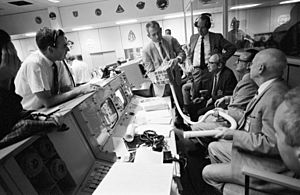
On the other side of the second row were controllers for specific parts of missions. For Apollo lunar flights, the TELMU and CONTROL controllers watched the Lunar Module. For Space Shuttle missions, PAYLOAD and EXPERIMENTS controllers were important. The INCO watched the spacecraft's communications.
The third row had the PAO, PROCEDURES, and the FAO (flight activities officer). The assistant flight director (AFD) and the main flight director were also here.
The fourth row was for NASA management, including the director of the Johnson Space Center and the chief astronaut.
Blue FCR (1998–2006)
The Blue FCR, used for ISS operations, had five rows of three consoles.
- The front row had ADCO, THOR, and PHALCON.
- The second row had OSO, ECLSS (pronounced "eekliss"), and ROBO.
- The third row had ODIN; either ACO (when the Shuttle was docked) or CIO (during free-flight); and OpsPlan.
- The fourth row had CATO, FLIGHT (flight director), and CAPCOM.
- The fifth row had GC; either RIO, EVA, VVO, or FDO; and SURGEON.
- The PAO was sometimes in the back right corner.
White FCR (1998–2011)

The White FCR, used for Space Shuttle operations, also had five rows.
- The front row (the "trench") had FDO (pronounced "fido"), who managed the orbit; either Guidance or rendezvous specialists; and GC, who managed the MCC's own computers.
- The second row had PROP (propulsion system); GNC (spacecraft attitude); MMACS (mechanical systems); and EGIL (pronounced "eagle") (fuel cells, electricity, oxygen, hydrogen).
- The third row had DPS (computer systems); ACO or Payloads (payload activities); FAO (flight plans); and EECOM (environmental systems).
- The fourth row had INCO (communications); FLIGHT—the Flight Director (in charge); CAPCOM (astronaut who talks to crew); and PDRS (robot arm).
- The back row had PAO (the "voice" of MCC); MOD (management); either RIO (for Mir flights), BOOSTER (for launch), or EVA (for spacewalks); and finally, SURGEON.
FCR 1 (2006–Present)

All US International Space Station operations are now controlled from FCR 1. This room was remodeled in 2006. It doesn't have the traditional tiered floor layout; all rows are on the same level.
In the past, a system called Gemini was used for ISS operations. This reduced the number of staff by combining six jobs into two "super-consoles" called Atlas and Titan. This allowed two people to do the work of up to eight during quiet times.
- TITAN (Telemetry, Information Transfer, and Attitude Navigation) handled Communications & Tracking (CATO), Command & Data Handling (ODIN), and Motion Control Systems (ADCO).
- ATLAS (Atmosphere, Thermal, Lighting and Articulation Specialist) handled Thermal Control (THOR), Environmental Control & Life Support (ECLSS), and Electrical Power Systems (PHALCON).
In 2010, after the ISS was mostly built, the Gemini concept was changed. The six main jobs were reduced to four:
- ETHOS (Environmental and Thermal Operating Systems) combines ECLSS and internal thermal control.
- SPARTAN (Station Power, ARticulation, Thermal, and ANalysis) handles electrical power and external thermal control.
- CRONUS (Communications RF Onboard Networks Utilization Specialist) combines the old ODIN and CATO jobs.
- ADCO (Motion Control Systems) remains the same.
Backup Control Centers
If the Houston MCC can't be used, for example, during a hurricane, NASA has backup locations.
- In 2017, during Hurricane Harvey, a hotel in Round Rock, Texas, was used as a temporary Backup Control Center (BCC).
- In 2020, for Hurricane Laura, the BCC was at the Columbia Scientific Balloon Facility in Palestine, Texas.
For longer-term needs, NASA can move ISS operations to the Huntsville Operations Support Center (HOSC) at Marshall Space Flight Center. For Hurricane Ike in 2008, NASA used both Round Rock and Huntsville for different tasks.
It's important to know that uncrewed US civilian satellites are controlled from the Goddard Space Flight Center in Maryland. Robotic US space probes are managed by the Jet Propulsion Laboratory in California.
Images for kids
-
White Flight Control Room prior to STS-114 in 2005


